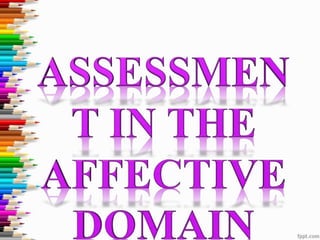
Affective domain taxonomy and instructional objectives
- 3. The taxonomy in the affective domain contains a large number of objectives in the literature expressed as interests, attitudes, appreciation, values, and emotional sets or biases. (Krathwohl et al, 1964). The descriptions of each step in the taxonomy culled from Krathwohl’s Taxonomy of Affective Domain (1964) are given as follows:
- 4. Is being aware of or sensitive to the existence of certain ideas, material or phenomena and being willing to tolerate them. Examples include: to differentiate, to accept, to listen (for), to respond to.
- 5. Is committed in some small measure to the ideas, materials or phenomena involved by actively responding to them. Examples are: to comply with, to follow, to commend, to volunteer, to spend leisure time in, to acclaim.
- 6. Is willing to be perceived by others as attaching importance to certain ideas, materials or phenomena. Examples include: to increase measured proficiency in, to relinquish, to subsidize, to support, to debate.
- 7. Is relating the value to those already held and bring it into a harmonious and internally consistent philosophy. Examples are: to discuss, to theorize, to formulate, to balance, to examine.
- 8. By value or value set is to act consistently in accordance with the values he or she internalized. Examples include: to revise, to require, to be rated high in the value, to avoid, to resist, to manage, to resolve.
- 10. Affective desired learning competencies are often stated in the form of instructional objectives. What the are instructional objectives?
- 11. Instructional objectives are specific, measurable, short term, observable student behaviors. Objectives are the foundation upon which you can build lessons and assessments that you can prove meet your overall course or lesson goals. Think of objectives as tools you use to make sure you reach your goals. They are the arrows you shoot towards your target (goal). The purpose of objectives is not to restrict spontaneity or constraint the vision of education in the discipline; but to ensure that learning is focused clearly enough that both students and teacher know what is going on, and to learning can be objectively measured. Different archers have different styles, so do different teachers. Thus, you can shoot your arrows (objectives) in many ways. The important thing is that they reach your target (goals) and score that bullseye!
- 12. LEVEL DEFINITION EXAMPLE RECEIVING Being aware of or attending to something in the environment Individual would read a book passage about civil rights RESPONDING Showing some new behaviors as a result of experience Individual would answer questions about the book, read another book by the same author, another book about civil rights, etc VALUING Showing some definite involvement or commitment The individual might demonstrate this by voluntarily attending a lecture on civil rights. ORGANIZATION Integrating a new value into one’s general set of values giving it some ranking among one’s general priorities The individual might arrange a civil rights rally CHARACTERIZATION BY VALUES Acting consistently with the new values The individual is firmly committed to the value, perhaps becoming a civil rights leader.
- 13. RECEIVING RESPONDING VALUING ORGANIZATION CHARACTERIZATION Accept Attend Develo p Recogn ize ∆Comple te ∆Comply ∆Cooper ate ∆Discuss ∆Examin e ∆Obey ∆Respon d Acce pt Defen d Devot e Pursu e Seek Codify Discrimi nate Display Order Organize Systemat ize Weigh ┼Internal ize ┼Verify
- 14. In the affective domain and in particular when we consider learning competencies we also consider the following focal concepts:
- 15. Attitudes are defined as a mental predisposition to act that is expressed by evaluating a particular entity with some degree of favor or disfavor. Individuals generally have attitudes that focus on objects, people or institutions. Attitudes are also attached to mental categories. Mental orientations towards concepts are generally reffered to as values. Attitudes are comprised of four components:
- 16. Cognitions are our beliefs, theories, expectancies, cause and effect beliefs, and perceptions relative to the focal object. This concept is not the same as “feelings” but just a statement of beliefs and expectations which vary from one individual to the next.
- 17. The affective component refers to our feeling with respect to the focal object such as fear, liking, or anger. For instance the color “blue” evokes different feelings for different individuals: some like the color blue other do not some associate the color blue with “loneliness” while others associate it with “calm and peace”.
- 18. BEHAVIORAL INTENTION Behavioral intentions are our goals, aspirations and our expected responses to the attitude object.
- 19. Evaluations are often considered the central component of attitudes. Evaluations consist of the imputations of some degree of goodness or badness to an attitude object. When we speak of a positive or negative attitude toward an object, we are referring to the evaluative component. Evaluations are a function of cognitive, affect and behavioral intentions of the object. It is most often the evaluation that is stored in memory, often without the evaluation corresponding cognitions and affect that were responsible for its formation. (Robert School, University of Rhode Island, 2002)
